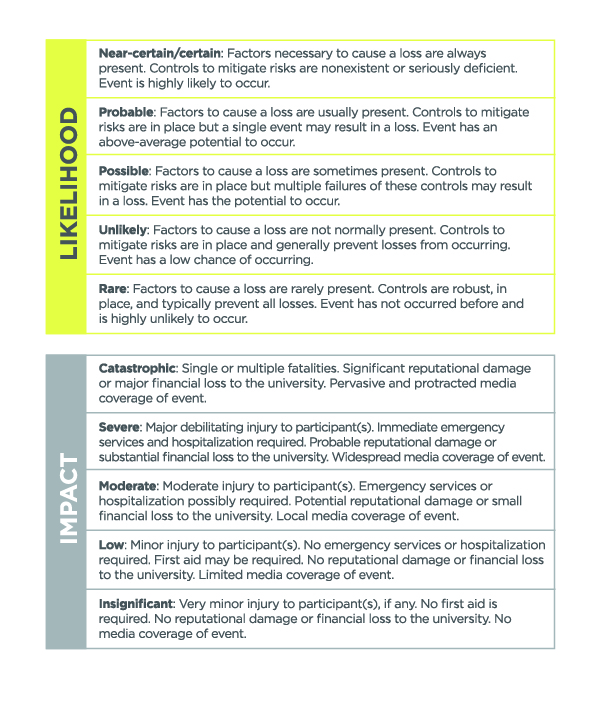Downloadable Resources
This fully accessible and interactive Risk Management Handbook will introduce you to the fundamentals of managing risks in experiential education at the University of Tennessee. You can download the handbook here: Experience Learning Risk Management Handbook
This two-page document lists the goals of risk management in the Experience Learning initiative, and introduces the Risk Management Cycle for Experience Learning.
The Impact and Likelihood Tables are five-point scales that can be used to establish the impact and likelihood of each of the hazards that you previously identified and listed in the Risk Identification and Assessment Table. Once you have determined the impact and likelihood of each hazard, you can fill in the remaining sections of the Risk Identification and Assessment Table, and then move on to completing the Risk Map. To learn more about how to assess risks in your experiential learning project, please refer to page 24 of the Experience Learning Risk Management Handbook.

The Risk Map is a tool that allows you to visualize and prioritize the risks you have identified and assessed in your experiential learning project. It is important to prioritize risks because this focuses the facilitator’s time and energy on managing the most urgent or dangerous risks first. Please refer to page 32 of the Experience Learning Risk Management Handbook for more information on managing risks in experiential education. You may download a Risk Map for your own use here.
For experiences required for course completion or graduation, we recommend that you work with your students to complete the Risk Identification and Mitigation Table PDF and have them sign the Assumption of Risk Statement at the bottom. This form has been approved by the University’s General Counsel and does not require further verification for use in experiential learning opportunities. Prior to working with students to complete this form, instructors should review the Risk Management Handbook and, if whenever possible, make it a priority to conduct a site visit before the beginning of the semester for which the experiential learning activity will take place in your class.
A release of claims waiver has also been approved by the University’s General Counsel for use in voluntary experiences only. This waiver should not be used for experiences required for course completion or progress toward graduation. Before asking students to sign this form, please reach out to Associate General Counsel Josh Walker to verify that this waiver is appropriate for your experience. If you receive approval, you should provide the waiver to students ahead of time so that they can review it carefully before signing and so that any student under the age of 18 can have their parent/guardian sign it.